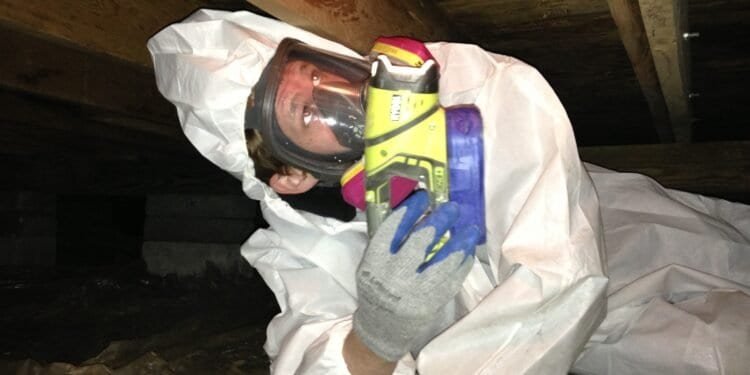Do you often find yourself sneezing uncontrollably, struggling to breathe, or experiencing skin rashes in your own home? If so, you may be one of the many individuals who are sensitive to mold. Mold, a type of fungus that thrives in damp and humid environments, can wreak havoc on the health and well-being of those with sensitivities. But fear not! In this blog post, we will explore essential tips that sensitive individuals can use to create a mold-free environment and finally bid farewell to those pesky mold-related symptoms. Living in a mold-free environment is not only crucial for sensitive individuals but for everyone’s overall health. Research has shown that exposure to mold can lead to a variety of health issues, ranging from respiratory problems to allergic reactions. Unfortunately, molds are incredibly common and can be found in various places in our homes, such as bathrooms, basements, and even on food. This makes it vital for individuals who are sensitive to mold to take proactive steps to eliminate it and prevent its recurrence. In the upcoming sections, we will delve into effective strategies that will help you create a mold-free environment in your home. From identifying potential mold sources to implementing preventive measures, we will provide you with a comprehensive guide to tackle this persistent problem. So, if you’re tired of constantly battling with mold and longing for a breath of fresh air, keep reading to discover the essential tips that will revolutionize your living space and ensure a healthier, mold-free future.
Understanding Mold Sensitivity: Causes and Symptoms
Mold sensitivity is caused by an allergic reaction to mold spores in the air. When individuals with mold sensitivity come into contact with these spores, their immune system overreacts, leading to a range of symptoms. Common symptoms of mold sensitivity include sneezing, coughing, itchy or watery eyes, nasal congestion, throat irritation, and skin rashes. These symptoms are similar to those experienced with other allergies, such as hay fever.
In more severe cases, individuals may experience difficulty breathing or asthma attacks. This can be particularly dangerous for individuals with pre-existing respiratory conditions, such as asthma or chronic obstructive pulmonary disease (COPD).
The causes of mold sensitivity can vary from person to person. Some individuals may have a genetic predisposition to allergies or asthma, making them more susceptible to mold sensitivity. Others may develop sensitivities over time due to repeated exposure to mold in their environment.
Certain factors can increase the likelihood of developing mold sensitivity. A weakened immune system, either due to illness or medication, can make individuals more susceptible. Additionally, individuals with pre-existing respiratory conditions, such as asthma or COPD, are at a higher risk of developing mold sensitivity.
It is important to note that mold sensitivity can occur in any type of environment, including both indoor and outdoor spaces. Mold thrives in damp and humid conditions, so areas with water damage or poor ventilation are more likely to have mold growth. Buildings with mold problems, such as water-damaged homes or offices, can pose a significant risk to individuals with mold sensitivity.
If you suspect that you may have mold sensitivity, it is important to consult with a healthcare professional for diagnosis and treatment options. In some cases, avoiding mold exposure and implementing measures to reduce mold growth in your environment may be sufficient to manage symptoms. In other cases, medications such as antihistamines or nasal corticosteroids may be recommended to alleviate symptoms.

Identifying Common Mold Sources in Your Home
To effectively combat mold growth in your home and create a mold-free environment, it is essential to identify common sources of mold. By addressing these sources directly, you can significantly reduce the risk of mold-related health issues.One common source of indoor mold is moisture buildup. Areas with high humidity levels or water leaks are particularly prone to mold growth. Bathrooms and kitchens are often hotspots for moisture accumulation due to steam from showers and cooking activities. Basements and crawl spaces are also susceptible to dampness and should be regularly inspected for signs of moisture.Another potential source of indoor mold is poor ventilation. Insufficient airflow can lead to stagnant air and increased humidity levels, creating an ideal environment for mold growth. Areas such as attics or rooms without windows should be adequately ventilated to prevent moisture buildup.
Assessing and Evaluating Mold Growth
Once you have identified potential mold sources in your home, the next step is to assess and evaluate the extent of mold growth. This will help you determine the appropriate course of action for remediation.Mold growth can often be visible, appearing as black or green patches on walls, ceilings, or other surfaces. However, mold can also grow in hidden areas such as behind wallpaper, under carpets, or inside air conditioning systems. In these cases, professional assistance may be required to accurately assess the extent of mold growth.If you suspect mold growth but cannot visually confirm it, there are various testing methods available. Air sampling and surface sampling can help identify the presence of mold spores and determine the type of mold present. These tests can be performed by professionals or using DIY kits available in the market.
Effective Mold Remediation Techniques
Once you have assessed and confirmed the presence of mold in your home, it is crucial to take immediate action to remediate the issue. Mold remediation involves removing existing mold colonies and preventing their recurrence.For small areas affected by mold growth, you can often handle the remediation process yourself. Begin by wearing protective gear such as gloves, goggles, and a mask to minimize exposure to mold spores. Then, clean affected surfaces using a mixture of water and detergent or a specialized mold cleaner. Ensure that all visible signs of mold are thoroughly removed.In cases where extensive mold growth is present or if you are unsure about handling the remediation process yourself, it is advisable to seek professional assistance. Professional remediation services have the expertise and equipment necessary to safely remove large-scale mold infestations.
Maintaining Proper Ventilation and Air Circulation
To prevent future occurrences of mold growth in your home, it is essential to maintain proper ventilation and air circulation throughout your living space. By improving airflow and reducing humidity levels, you can create an environment that is less conducive to mold growth.Start by ensuring that all rooms in your home have adequate ventilation. This can be achieved through the installation of exhaust fans in bathrooms and kitchens or by opening windows to allow fresh air to circulate. Additionally, using dehumidifiers in areas prone to moisture buildup can help regulate humidity levels and prevent mold growth.Regularly inspecting and cleaning air conditioning systems, including filters and ducts, is also crucial for maintaining proper ventilation. These systems can accumulate dust, debris, and moisture, providing an ideal breeding ground for mold if not properly maintained.

Managing Humidity Levels to Prevent Mold Growth
Humidity control is a key factor in preventing mold growth. By managing humidity levels in your home, you can significantly reduce the risk of mold-related issues.Ideally, indoor humidity should be kept below 50%. To achieve this, consider using a hygrometer to monitor humidity levels regularly. If levels exceed the recommended range, take steps to reduce moisture in the air.One effective method of reducing humidity is through the use of dehumidifiers. These devices extract excess moisture from the air, helping maintain optimal humidity levels. Place dehumidifiers in areas prone to high humidity or where previous mold growth has occurred.Proper ventilation plays a crucial role in managing humidity as well. Ensure that bathrooms and kitchens are adequately ventilated during activities that generate steam or moisture. Additionally, avoid drying clothes indoors as this can increase indoor humidity levels significantly.
Cleaning and Disinfecting Strategies to Combat Mold
Regular cleaning and disinfecting are essential for preventing mold growth and maintaining a mold-free environment. By implementing effective cleaning strategies, you can eliminate potential sources of mold spores and inhibit their growth.When cleaning areas prone to moisture such as bathrooms or kitchens, use products specifically designed for mold prevention. These cleaners often contain ingredients such as bleach or hydrogen peroxide that effectively kill mold spores on contact.Pay special attention to areas that are frequently exposed to moisture, such as shower curtains, bath mats, or kitchen sinks. Regularly clean and dry these items to prevent mold growth.In addition to regular cleaning, it is crucial to address any water leaks or plumbing issues promptly. Even minor leaks can lead to significant mold growth if left unattended. Repairing leaks and drying affected areas thoroughly will help prevent mold from taking hold.
Utilizing Mold-Resistant Materials in Your Home
When renovating or building a new home, consider utilizing mold-resistant materials. These materials are designed to inhibit the growth of mold and can significantly reduce the risk of mold-related issues.Mold-resistant drywall is an excellent option for areas prone to moisture such as bathrooms or basements. This type of drywall contains additives that make it more resistant to mold growth compared to traditional drywall.For flooring options, consider materials such as ceramic tiles or vinyl that are less susceptible to moisture absorption. These materials are easier to clean and less likely to harbor mold spores.
Regular Inspections and Prevention Methods to Stay Mold-Free
To maintain a mold-free environment in your home, it is essential to conduct regular inspections and implement preventive measures consistently. By staying vigilant and proactive, you can minimize the risk of recurring mold issues.Schedule regular inspections of your home for signs of moisture buildup or visible mold growth. Pay attention to areas such as bathrooms, kitchens, basements, and crawl spaces where humidity levels tend to be higher.Address any signs of water damage immediately. Whether it’s a leaky pipe or a roof leak, prompt repairs will help prevent further damage and potential mold growth.Implement preventive measures such as using exhaust fans during showers or cooking activities and regularly cleaning air conditioning filters. These simple steps can go a long way in maintaining a healthy indoor environment.
Are you one of the many individuals who are sensitive to mold? If so, creating a mold-free environment in your home is crucial for your health and well-being. In addition to using materials that are resistant to moisture absorption, there are several other steps you can take to prevent mold growth.
Regular inspections play a vital role in maintaining a mold-free home. Make it a habit to inspect your home regularly for any signs of moisture buildup or visible mold growth. Pay close attention to areas that are prone to high humidity levels, such as bathrooms, kitchens, basements, and crawl spaces. If you notice any signs of water damage, it’s important to address them promptly.
Prompt repairs are essential in preventing further damage and potential mold growth. Whether it’s fixing a leaky pipe or repairing a roof leak, taking immediate action can save you from future mold problems. In addition to inspections and repairs, implementing preventive measures is crucial. Make use of exhaust fans during showers or cooking activities to reduce moisture buildup. Regularly cleaning air conditioning filters can also help maintain a healthy indoor environment.
By following these essential tips and staying vigilant, you can create a mold-free environment that is safe and comfortable for sensitive individuals like you. Say goodbye to mold and enjoy a healthier home.
Can mold cause health problems?
The presence of mold can pose various health risks, as it produces allergens (substances that can trigger allergic reactions), irritants, and, in some cases, potentially harmful substances known as mycotoxins. Allergic individuals may experience symptoms such as hay fever-like reactions including sneezing, runny nose, red eyes, and dermatitis (skin rash) when exposed to mold or mold spores through inhalation or physical contact. Moreover, molds gradually deteriorate the materials they grow on. By effectively managing moisture and preventing mold growth, you can safeguard your home, belongings, save money, and minimize potential health hazards. Allergies induced by mold are quite common and can occur immediately or with a delayed response. Furthermore, individuals with asthma who are allergic to mold can experience asthma attacks triggered by mold exposure. Mold can also cause irritation to the eyes, skin, nose, throat, and lungs of both mold-allergic and non-allergic individuals. Although uncommon, symptoms other than allergic reactions and irritations resulting from mold inhalation are not frequently reported. Research on the health effects of mold exposure is continuously being conducted. While this information offers a concise overview, it does not encompass all potential health effects related to mold exposure. For more comprehensive details, it is advisable to seek guidance from a healthcare professional or consult your local/state health department.
Why is mold growing in my home?
Molds are an integral component of the natural ecosystem. When found outdoors, molds contribute to the decomposition of deceased organic materials like fallen leaves and decaying trees. However, the presence of mold indoors should be prevented. Mold reproduces through minuscule spores that are impossible to see with the naked eye and are dispersed in both outdoor and indoor air. In indoor environments, mold can thrive when these spores land on wet surfaces. It’s important to note that mold requires water or moisture in order to grow, and without it, no type of mold can flourish.
Conclusion: Achieving a Mold-Free Environment for a Healthier Future
Creating a mold-free environment is essential for sensitive individuals and anyone concerned about their health. By understanding the causes and symptoms of mold sensitivity, identifying common mold sources, and implementing effective remediation techniques, you can significantly reduce the risk of mold-related health issues.Maintaining proper ventilation and air circulation, managing humidity levels, and utilizing mold-resistant materials are key strategies for preventing mold growth. Regular inspections and consistent preventive measures will help ensure a mold-free environment in your home.By following these essential tips, sensitive individuals can bid farewell to mold-related symptoms and enjoy a healthier living space. Say goodbye to mold and embrace a breath of fresh air in your home!














